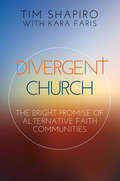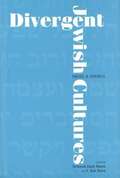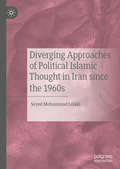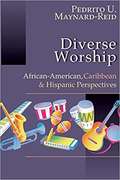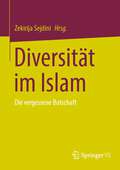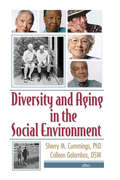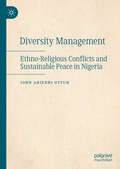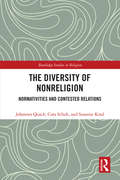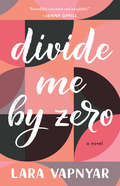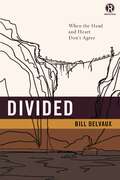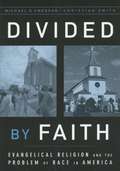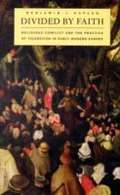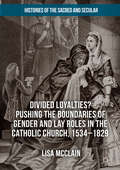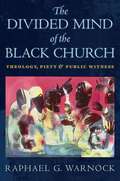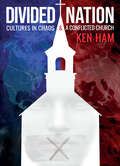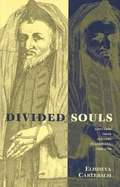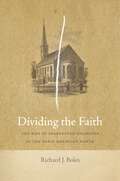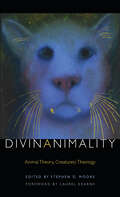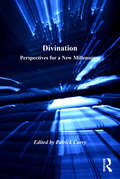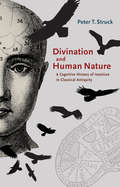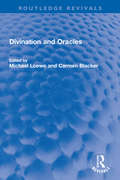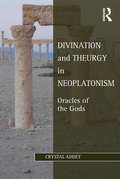- Table View
- List View
Divergent Church: The Bright Promise of Alternative Faith Communities
by Tim Shapiro Kara FarisNew faith communities are appearing across the U.S.. Many of them bear little resemblance—on the surface—to ‘church’ in its conventional form. But when we look a little deeper we see striking continuity with the most deeply rooted practices of the Christian faith in community. What are those practices? What do these unconventional, alternative faith communities look like? How are they, perhaps, indicators of a hopeful new future for the church? And what can we learn from them? Authors Kara Brinkerhoff and Tim Shapiro spent more than a year researching and exploring these questions, closely examining the life of a dozen alternative faith communities across the country. They include new monastic communities, food-oriented communities, affinity group communities, house churches, hybrid churches and others. They are creative, ingenious, innovative, clever, dynamic and transformative. But they represent human expressions of activities that have always been part of human religious congregations: hospitality, learning, storytelling, care, leadership, worship and honoring place. This fascinating book goes beyond simply analyzing current trends. It reveals how innovative Christians are engaging in time-honored practices, creating new types of communities, which will shape the church to come. Further, it shows us how we too might innovate while holding true to the essential practices of our gathered faith. This is an instructive picture of Christian community, past, present and future.
Divergent Jewish Cultures: Israel and America
by Deborah Dash Moore S. Ilan TroenThis book is the third in the series Studies in Jewish Culture and Society, published by the Center for Advanced Judaic Studies of the University of Pennsylvania.
Diverging Approaches of Political Islamic Thought in Iran since the 1960s
by Seyed Mohammad LolakiThis book argues that Political Islam in the Iranian context evolved into three main schools of thought during the 1960s and 1970s: Jurisprudential Islam led by Ayatollah Khomeini, Leftist Islam led by Shariati, and Liberal Islam led by Bazargan. Despite the fact that all schools seek an Islamic state, their chosen methods and philosophical approaches diverge considerably. The synthesis of these three contrasting socio-political views is structured here to provide a coherent interpretation by means of ongoing comparison. This method has so far not been presented in academic studies within the field of Political Islam.Furthermore, this book provides a critical analysis of the aforementioned ‘Political Islam’ schools in Iran, their similarities and differences, relative success or failure, their contribution to the revolution of 1979 and how they have evolved from the pre-revolution era to the present.
Diverse Worship: African-American, Caribbean and Hispanic Perspectives
by Pedrito U. Maynard-ReidLet the nations sing. What are the universal constants of Christian worship? What are the unique elements that arise out of diverse local contexts? How do we appropriately respect and honor both the constancy and the diversity? In Diverse Worship Pedrito U. Maynard-Reid explores the multiethnic dimensions of worship by looking at three specific cultural contexts--African-American, Caribbean and Hispanic. After surveying worship and culture through history, he devotes a section of his book to each of these three cultural context for worship. Maynard-Reid colorfully describes and characterizes each worship tradition, and he explores its historical development and change. Throughout this engaging and enlightening book, we gain new perspective on what it means to worship God.
Diversität im Islam: Die vergessene Botschaft
by Julia EitzingerDer Islam gehört zu den wichtigsten gesellschaftspolitischen Themen in Europa. Durch den Einfluss weltpolitischer Ereignisse, aber auch religiös motivierter Gewalttaten ist ein autoritäres und teilweise pluralitätsfeindliches Islambild entstanden. Dabei wird die innerislamische Pluralität ausgeblendet, was die weitverbreitete Annahme verstärkt, der Islam sei von seinem Wesen heterogenitätsunfähig. Jedoch war und ist der Islam als universelle Religion, die sich an die gesamte Menschheit richtet, in vielen Kulturen beheimatet, sodass es unterschiedliche Verständnisse und Prägungen gibt. Der Sammelband thematisiert diesen für unseren aktuellen Kontext höchst relevanten Aspekt, indem Expertinnen und Experten die vielfältigen Zugänge zum Islam darstellen.
Diversity and Aging in the Social Environment
by Sherry M. Cummings Colleen GalambosToday, nearly one of every eight Americans is 65 or older, and by 2030, over 20% of the population will be in this age group. Are you prepared to work with this vastly diverse-and rapidly growing-population?This single source is designed to help social service professionals provide effective services to America&’s vastly diverse and rapidly growing elderly population. Diversity and Aging in the Social Environment explores the impact of race/ethnicity, gender, sexual orientation, and geographic location on elders&’ strengths, challenges, needs, and resources to provide you with a more complete understanding of the issues elders face. In order to be more responsive to older adults, social workers and other human service professionals need to enhance their knowledge of the aging population and the factors that impact the way seniors interact with society, organizations, community resources, neighborhoods, support networks, kinship groups, family, and friends. Diversity and Aging in the Social Environment examines differences in race, ethnicity, geographical location, sexual orientation, religion, and health status to help current and future human service professionals provide culturally competent services to the diverse range of elderly people they serve. In addition, it addresses the wide disparity that exists for older Americans in terms of income and assets, number of chronic conditions, functional and cognitive impairment, housing arrangements, and access to health care. This book provides a context for the examination of diversity issues among older adults by describing and discussing several theoretical perspectives on aging that highlight important aspects of diversity. Next, you&’ll find thoughtful examinations of: issues and challenges faced by lesbian, gay, bisexual, and transgender elders-and the strengths they bring into later life the impact of gender, race, and sexual orientation on prevalence rates, risk factors, methods of disease contraction, and mortality rates among older adults with HIV/AIDS-along with a discussion of the psychosocial issues they face diverse characteristics of custodial grandparents-and the influence of the caregivers&’ gender, race, age, and geographic location on methods of care and available caregiver support differences in caregiver characteristics, service utilization, caregiver strain, and coping mechanisms among several racial/ethnic groups of adults who care for elderly, disabled, and ill persons cultural/religious factors that influence interactions between health care personnel and Japanese-American elders the relationship between acculturation and depressive symptoms among Mexican-American couples life challenges facing Jewish and African-American elders-with a look at each group&’s coping mechanisms differences in religious/spiritual coping skills among Native American, African-American, and white elders psychological well-being and religiosity among a diverse group of rural elders
Diversity Management: Ethno-Religious Conflicts and Sustainable Peace in Nigeria
by John Arierhi OttuhThis book offers a historical analysis as well as contextual management strategy on Nigeria’s lingering ethno-religious conundrums. From a rigorous examination of ethno-religious related violence—considering historical events such as the Civil War, Niger Delta armed struggle, and the rise of Boko Haram—to the application of philosophical, religious, and social frameworks for peacebuilding. This book provides a comprehensive overview of the challenges and potential solutions for managing the complex heterogeneous ethno-religious diversity in Nigeria (and Africa) by exploring survey, sacred texts, and relevant theories like Kantian and Gurr’s RD theories. Moreover, the book provides insights for policy makers on how ethno-religiously diverse society normatively induce conflicts, and discusses the importance of proactive policies that enhance good governance and prevent violent conflicts that may fester if unattended. This work would be beneficial to scholars and students of religious studies, peace studies, political science, history, social studies, and Africans and Africans in Diaspora.
The Diversity of Nonreligion: Normativities and Contested Relations (Routledge Studies in Religion)
by Johannes Quack Cora Schuh Susanne KindThis book explores the relational dynamic of religious and nonreligious positions as well as the tensions between competing modes of nonreligion. Across the globe, individuals and communities are seeking to distinguish themselves in different ways from religion as they take on an identity unaffiliated to any particular faith. The resulting diversity of nonreligion has until recently been largely ignored in academia. Conceptually, the book advances a relational approach to nonreligion, which is inspired by Pierre Bourdieu’s field theory. It also offers further analytical distinctions that help to identify and delineate different modes of nonreligion with respect to actors’ values, objectives, and their relations with relevant religious others. The significance of this conceptual frame is illustrated by three empirical studies, on organized humanism in Sweden, atheism and freethought in the Philippines, and secular politics in the Netherlands. These studies analyze the normativities and changing positions of different groups against the background of both institutionalized religious practice and changing religious fields more generally. This is a fascinating exploration of how nonreligion and secularities are developing across the world. It complements existing approaches to the study of religion, secularity, and secularism and will, therefore, be of great value to scholars of religious studies as well as the anthropology, history, and sociology of religion more generally.
The Diversity Of Worldviews Among Young Adults: Contemporary (Non)Religiosity And Spirituality Through The Lens Of An International Mixed Method Study
by Peter Nynäs Ariela Keysar Janne Kontala Ben-Willie Kwaku Golo Mika T. Lassander Marat Shterin Sofia Sjö Paul StennerThis open access volume features a data-rich portrait of what young adults think about the world. It collects the views of students in higher education from various cultural regions, religious traditions, linguistic groups, and political systems. This will help readers better understand a generation that will soon rise to power and influence.The analysis focuses on 12 countries. These include Canada, China, Finland, Ghana, India, Israel, Peru, Poland, Russia, Sweden, Turkey, and the USA. It employs a mixed-methods approach, invested in the study of an individual's views and values using state-of-the-art methodology, including the innovative Faith Q-sort. This instrument is new to the field and developed for assessing the entanglement of subjective views and personal beliefs. The study also incorporates a comprehensive values survey as well as other survey tools that look into people's social capital, media use, social values alignment, and subjective well-being. Each chapter is co-authored by an international team of scholars with research interest in the particular topic. The rationale for this principle is the need to engage individuals from different cultural backgrounds, scholarly disciplines, and methodological and substantive competences. In the end, this innovative approach presents an informed, empirically grounded analysis of the values and worldviews of the future generation. It sheds an important light on how changes in the religious landscape are intertwined with broad and diffuse processes of socio-economic and global cultural change.
Divide Me By Zero
by Lara Vapnyar"In her superb and poignant new novel, Lara Vapnyar writes about love and other difficulties with the same passion, wit, and probing intelligence to be found in all her writing. Among its many treasures, Divide Me By Zero contains fascinating explorations of the fraught, tangled nature of both romantic and family relationships, and some of the most affecting scenes of bereavement I have ever read." —Sigrid Nunez, The Friend <P><P>As a young girl, Katya Geller learned from her mother that math was the answer to everything. Now, approaching forty, she finds this wisdom tested: she has lost the love of her life, she is in the middle of a divorce, and has just found out that her mother is dying. Half-mad with grief, Katya turns to the unfinished notes for her mother’s last textbook, hoping to find guidance in mathematical concepts. <P><P>With humor, intelligence, and unfailing honesty, Katya traces back her life’s journey: her childhood in Soviet Russia, her parents’ great love, the death of her father, her mother’s career as a renowned mathematician, and their immigration to the United States. She is, by turns, an adrift newlywed, an ESL teacher in an office occupied by witches and mediums, a restless wife, an accomplished writer, a flailing mother of two, a grieving daughter, and, all the while, a woman in love haunted by a question: how to parse the wild, unfathomable passion she feels through the cool logic of mathematics? <P><P>Award-winning author Lara Vapnyar delivers an unabashedly frank and darkly comic tale of coming-of-age in middle age. Divide Me by Zero is almost unclassifiable—a stylistically original, genre-defying mix of classic Russian novel, American self-help book, Soviet math textbook, sly writing manual, and, at its center, an intense romance that captures the most common misfortune of all: falling in love.
Divided: Refraction (Refraction)
by Bill DelvauxThe longest distance in the universe is between the head and heart. For Christ-followers, it is the chasm between what we say we believe in our minds and what we truly believe in our hearts: a split between our statements about God and our experience of Him. This divide is everywhere around us, causing untold devastation. It is found in the double lives of believers and in the hypocrisy of church leaders, but mainly we see it in ourselves. It is the default position of every human heart. In Divided: When the Head and Heart Don't Agree, Bill Delvaux exposes this divide and offers strategies to tackle it. The actual journey to cross the divide is sketched out, an epic journey that will take us into our deepest fear and shame and on into the wonder of God's presence. For becoming undivided is not just another task. It's the pathway into the very heart of the Father. Features include: Strategies for closing the divide between head and heart Specific prayers for each stage of the spiritual journey Thought-provoking questions for spiritual conversation or reflection
Divided By Faith: Evangelical Religion And The Problem Of Race In America
by Michael O. Emerson Christian SmithThrough a nationwide telephone survey of 2,000 people and an additional 200 face-to-face interviews, Michael O. Emerson and Christian Smith probed the grassroots of white evangelical America. They found that despite recent efforts by the movement's leaders to address the problem of racial discrimination, evangelicals themselves seem to be preserving America's racial chasm. In fact, most white evangelicals see no systematic discrimination against blacks. But the authors contend that it is not active racism that prevents evangelicals from recognizing ongoing problems in American society. Instead, it is the evangelical movement's emphasis on individualism, free will, and personal relationships that makes invisible the pervasive injustice that perpetuates racial inequality. Most racial problems, the subjects told the authors, can be solved by the repentance and conversion of the sinful individuals at fault. Combining a substantial body of evidence with sophisticated analysis and interpretation, the authors throw sharp light on the oldest American dilemma. In the end, they conclude that despite the best intentions of evangelical leaders and some positive trends, real racial reconciliation remains far over the horizon.
Divided By Faith: Religious Conflict and the Practice of Toleration in Early Modern Europe
by Benjamin J. KaplanAs religious violence flares around the world, we are confronted with an acute dilemma: Can people coexist in peace when their basic beliefs are irreconcilable? Benjamin Kaplan responds by taking us back to early modern Europe, when the issue of religious toleration was no less pressing than it is today. Divided by Faith begins in the wake of the Protestant Reformation, when the unity of western Christendom was shattered, and takes us on a panoramic tour of Europe's religious landscape--and its deep fault lines--over the next three centuries. Kaplan's grand canvas reveals the patterns of conflict and toleration among Christians, Jews, and Muslims across the continent, from the British Isles to Poland. It lays bare the complex realities of day-to-day interactions and calls into question the received wisdom that toleration underwent an evolutionary rise as Europe grew more "enlightened. " We are given vivid examples of the improvised arrangements that made peaceful coexistence possible, and shown how common folk contributed to toleration as significantly as did intellectuals and rulers. Bloodshed was prevented not by the high ideals of tolerance and individual rights upheld today, but by the pragmatism, charity, and social ties that continued to bind people divided by faith. Divided by Faith is both history from the bottom up and a much-needed challenge to our belief in the triumph of reason over faith. This compelling story reveals that toleration has taken many guises in the past and suggests that it may well do the same in the future.
Divided by Faith: Religious Conflict and the Practice of Toleration in Early Modern Europe
by Benjamin J. KaplanAs religious violence flares around the world, we are confronted with an acute dilemma: Can people coexist in peace when their basic beliefs are irreconcilable? Benjamin Kaplan responds by taking us back to early modern Europe, when the issue of religious toleration was no less pressing than it is today. Divided by Faith begins in the wake of the Protestant Reformation, when the unity of western Christendom was shattered, and takes us on a panoramic tour of Europe's religious landscape--and its deep fault lines--over the next three centuries. Kaplan's grand canvas reveals the patterns of conflict and toleration among Christians, Jews, and Muslims across the continent, from the British Isles to Poland. It lays bare the complex realities of day-to-day interactions and calls into question the received wisdom that toleration underwent an evolutionary rise as Europe grew more "enlightened." We are given vivid examples of the improvised arrangements that made peaceful coexistence possible, and shown how common folk contributed to toleration as significantly as did intellectuals and rulers. Bloodshed was prevented not by the high ideals of tolerance and individual rights upheld today, but by the pragmatism, charity, and social ties that continued to bind people divided by faith. Divided by Faith is both history from the bottom up and a much-needed challenge to our belief in the triumph of reason over faith. This compelling story reveals that toleration has taken many guises in the past and suggests that it may well do the same in the future.
Divided Loyalties? Pushing the Boundaries of Gender and Lay Roles in the Catholic Church, 1534-1829 (Histories of the Sacred and Secular, 1700-2000)
by Lisa McClainThis book explores changing gender and religious roles for Catholic men and women in the British Isles from Henry VIII’s break with the Catholic Church in 1534 to full emancipation in 1829. Filled with richly detailed stories, such as the suppression of Mary Ward’s Institute of English Ladies, it explores how Catholics created and tested new understandings of women’s and men’s roles in family life, ritual, religious leadership, and vocation through engaging personal narratives, letters, trial records, and other rich primary sources. Using an intersectional approach, it crafts a compelling narrative of three centuries of religious and social experimentation, adaptation, and change as traditional religious and gender norms became flexible during a period of crisis. The conclusions shed new light on the Catholic Church’s long-term, ongoing process of balancing gendered and religious authority during this period while offering insights into the debates on those topics taking place worldwide today.
The Divided Mind of the Black Church: Theology, Piety, and Public Witness (Religion, Race, and Ethnicity)
by Raphael G WarnockAn &“altar call to action&” from the U.S. senator and senior pastor at Atlanta&’s Ebenezer Baptist Church (Publishers Weekly). What is the true nature and mission of the church? Is its proper Christian purpose to save souls, or to transform the social order? This question is especially fraught when the church is one built by an enslaved people and formed, from its beginning, at the center of an oppressed community&’s fight for personhood and freedom. Such is the central tension in the identity and mission of the Black church in the United States. For decades the Black church and Black theology have held each other at arm&’s length. Black theology has emphasized the role of Christian faith in addressing racism and other forms of oppression, arguing that Jesus urged his disciples to seek the freedom of all peoples. Meanwhile, the Black church, even when focused on social concerns, has often emphasized personal piety rather than social protest. With the rising influence of white evangelicalism, biblical fundamentalism, and the prosperity gospel, the divide has become even more pronounced. This book traces the historical significance of the rise and development of Black theology as an important conversation partner for the Black church. Calling for honest dialogue between Black and womanist theologians and Black pastors, this fresh theological treatment demands a new look at the church&’s essential mission. &“An informative work for historians, theologians, and humanities scholars interested in debating what the Black Church needs to be doing in the 21st century.&” ―Journal of African American History &“As a person who is not Black, reading this book provided a learning experience for me . . . I could also see this book serving as a way to spark discussion involving all ethnic groups as to how we can all, as fellow Christians, blend the goals of saving lost people and moving the culture toward equality for everyone.&” ―Ministry &“Well-written and meticulously researched.&” ―The Christian Century
Divided Nation: Cultures in Chaos & A Conflicted Church
by Ken HamDivided Nation: Cultures in Chaos & A Conflicted Church provides families and their churches biblical mandates to awaken and arise as influencers in today’s turbulent times. As Christian persecution increases, the Body of Christ needs to prepare to take a bold stand. Ken Ham, CEO and founder of Answers in Genesis-US, the highly acclaimed Creation Museum, and the world-renowned Ark Encounter, sounds the call for Reformation bringing God’s people back to the authority of the Word of God beginning in Genesis. Can the church regain a position of influence among this generation of “truth seekers” who reject God and His Word? To combat today’s chaotic culture and the conflicted church, Ham addresses five specific issues: There is no neutral position There is no non-religious position There are ultimately only two religions Creation apologetics How to think foundationally to develop a truly Christian worldview Make a stand for the soul of this generation. Divided Nation shines an empowering light on the struggle of the church to retain young believers. Glean from it the issues that must be addressed and find clarity amid the chaos of the culturally conflicted church. “Divided Nation is an excellent call to Christians, pastors and thinkers alike to return to the supreme authority of God’s Word and the God of all truth.” Jack Hibbs – Calvary Chapel: Chino Hills, CA
Divided Souls: Converts from Judaism in Germany, 1500-1750
by Elisheva CarlebachCarlebach (history, Queens College and CUNY) writes that while conversion usually summoned up a kind of transfiguration and rebirth into a superior religion, the meaning began eroding when speaking of 16th century German Jews. Christians increasingly saw Jewish converts as "`taufjuden,' baptized, but not truly converted," a sentiment derived from earlier centuries with the crusaders. Carlebach's close readings of writings by converts provide instruction in Christian self-definition and Jewish identity in German lands. Overwhelmingly, the Jewish side of these uneasy converts never atrophied, but instead had a positive effect on their new Christian identity. Such converts would become central in the formation of a Jewish image held by both Christians and Jews for years to come.
Dividing the Faith: The Rise of Segregated Churches in the Early American North (Early American Places #17)
by Richard J BolesUncovers the often overlooked participation of African Americans and Native Americans in early Protestant churchesPhillis Wheatley was stolen from her family in Senegambia, and, in 1761, slave traders transported her to Boston, Massachusetts, to be sold. She was purchased by the Wheatley family who treated Phillis far better than most eighteenth-century slaves could hope, and she received a thorough education while still, of course, longing for her freedom. After four years, Wheatley began writing religious poetry. She was baptized and became a member of a predominantly white Congregational church in Boston. More than ten years after her enslavement began, some of her poetry was published in London, England, as a book titled Poems on Various Subjects, Religious and Moral. This book is evidence that her experience of enslavement was exceptional. Wheatley remains the most famous black Christian of the colonial era. Though her experiences and accomplishments were unique, her religious affiliation with a predominantly white church was quite ordinary. Dividing the Faith argues that, contrary to the traditional scholarly consensus, a significant portion of northern Protestants worshipped in interracial contexts during the eighteenth century. Yet in another fifty years, such an affiliation would become increasingly rare as churches were by-and-large segregated.Richard Boles draws from the records of over four hundred congregations to scrutinize the factors that made different Christian traditions either accessible or inaccessible to African American and American Indian peoples. By including Indians, Afro-Indians, and black people in the study of race and religion in the North, this research breaks new ground and uses patterns of church participation to illuminate broader social histories. Overall, it explains the dynamic history of racial integration and segregation in northern colonies and states.
Divinanimality: Animal Theory, Creaturely Theology (Transdisciplinary Theological Colloquia)
by Stephen D. MooreA turn to the animal is underway in the humanities, most obviously in such fields as philosophy, literary studies, cultural studies, and religious studies. One important catalyst for this development has been the remarkable body of animal theory issuing from such thinkers as Jacques Derrida and Donna Haraway. What might the resulting interdisciplinary field, commonly termed animality studies, mean for theology, biblical studies, and other cognate disciplines? Is it possible to move from animal theory to creaturely theology?This volume is the first full-length attempt to grapple centrally with these questions. It attempts to triangulate philosophical and theoretical reflections on animality and humanity with theological reflections on divinity. If the animal–human distinction is being rethought and retheorized as never before, then the animal–human–divine distinctions need to be rethought, retheorized, and retheologized along with it. This is the task that the multidisciplinary team of theologians, biblical scholars, philosophers, and historians assembled in this volume collectively undertakes. They do so frequently with recourse to Derrida’s animal philosophy and also with recourse to an eclectic range of other relevant thinkers, such as Haraway, Giorgio Agamben, Emmanuel Levinas, Gloria Anzaldua, Helene Cixous, A. N. Whitehead, and Lynn White Jr.The result is a volume that will be essential reading for religious studies audiences interested in ecological issues, animality studies, and posthumanism, as well as for animality studies audiences interested in how constructions of the divine have informed constructions of the nonhuman animal through history.
Divination: Perspectives for a New Millennium
by Patrick CurryDivination is any ritual and its associated tradition performed in order to ask a more-than-human intelligence for guidance. A universal human practice, it has received surprisingly little academic attention. This interdisciplinary collection by leading scholars in the field is dedicated to fascinating new insights into divination and oracles arising from recent work in anthropology, religious studies, history and classical studies. Central importance is given to the practical and theoretical perspectives of diviners as well as scholars of divination; several contributors are both. This book explores philosophical issues such as the nature of divinatory intelligence, the relationship between divinatory and metaphorical truth, the primacy of ontology over epistemology, the importance of reflexivity in scholarly studies of divination, and astrology as the principal Western form of divination. The ethnographic and historical examples range from contemporary Nigeria, urban Cuba, Mayan Guatemala and the shamanic cultures of the circumpolar Arctic to classical Greece and ancient Judea.
Divination and Human Nature: A Cognitive History of Intuition in Classical Antiquity
by Peter T. StruckDivination and Human Nature casts a new perspective on the rich tradition of ancient divination--the reading of divine signs in oracles, omens, and dreams. Popular attitudes during classical antiquity saw these readings as signs from the gods while modern scholars have treated such beliefs as primitive superstitions. In this book, Peter Struck reveals instead that such phenomena provoked an entirely different accounting from the ancient philosophers. These philosophers produced subtle studies into what was an odd but observable fact--that humans could sometimes have uncanny insights--and their work signifies an early chapter in the cognitive history of intuition.Examining the writings of Plato, Aristotle, the Stoics, and the Neoplatonists, Struck demonstrates that they all observed how, setting aside the charlatans and swindlers, some people had premonitions defying the typical bounds of rationality. Given the wide differences among these ancient thinkers, Struck notes that they converged on seeing this surplus insight as an artifact of human nature, projections produced under specific conditions by our physiology. For the philosophers, such unexplained insights invited a speculative search for an alternative and more naturalistic system of cognition.Recovering a lost piece of an ancient tradition, Divination and Human Nature illustrates how philosophers of the classical era interpreted the phenomena of divination as a practice closer to intuition and instinct than magic.
Divination and Oracles (Routledge Revivals)
by Michael Loewe; Carmen BlackerFirst published in 1981, Divination and Oracles analyses the religious practices of the ancient world as they have been witnessed from Scandinavia to Tibet and Japan, from the third millennium BC until the present day. Divination and the consultation of oracles formed part of the religious practice of the ancient world and are part of the living folklore of the contemporary societies. They are subjects that are of immediate concern to anthropologists and not infrequently to the historians of early science. Written by the specialists in the early history of European and Asian Civilisations, the chapters call on the evidence of the written word of history and the surviving artefacts and inscriptions of archaeology. They describe the different methods that have been adopted and examine the types of question that feature in man’s attempt to seek guidance from other powers. The contributions show how an appeal to the irrational can affect the decision of prophet or statesman, or the way of life of farmer or sailor; and how such an appeal can also stimulate scientific enquiry into the cycles of nature. This book is a must read for scholars and researchers of religion, comparative religion, and ancient history.
Divination and Prediction in Early China and Ancient Greece
by Lisa RaphalsDivination was an important and distinctive aspect of religion in both ancient China and ancient Greece, and this book will provide the first systematic account and analysis of the two side by side. Who practised divination in these cultures and who consulted it? What kind of questions did they ask, and what methods were used to answer those questions? As well as these practical aspects, Lisa Raphals also examines divination as a subject of rhetorical and political narratives, and its role in the development of systematic philosophical and scientific inquiry. She explores too the important similarities, differences and synergies between Greek and Chinese divinatory systems, providing important comparative evidence to reassess Greek oracular divination.
Divination and Theurgy in Neoplatonism: Oracles of the Gods (Studies in Philosophy and Theology in Late Antiquity)
by Crystal AddeyWhy did ancient philosophers consult oracles, write about them, and consider them to be an important part of philosophical thought and practice? This book explores the extensive links between oracles and philosophy in Late Antiquity, particularly focusing on the roles of oracles and other forms of divination in third and fourth century CE Neoplatonism. Examining some of the most significant debates between pagan philosophers and Christian intellectuals on the nature of oracles as a central yet contested element of religious tradition, Addey focuses particularly on Porphyry's Philosophy from Oracles and Iamblichus' De Mysteriis - two works which deal extensively with oracles and other forms of divination. This book argues for the significance of divination within Neoplatonism and offers a substantial reassessment of oracles and philosophical works and their relationship to one another. With a broad interdisciplinary approach, encompassing Classics, Ancient Philosophy, Theology, Religious Studies and Ancient History, Addey draws on recent anthropological and religious studies research which has challenged and re-evaluated the relationship between rationality and ritual.
